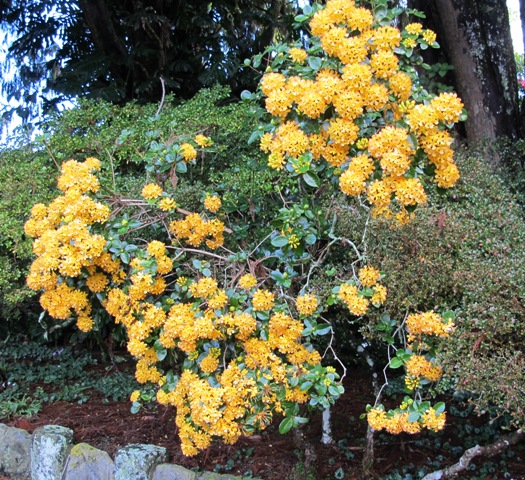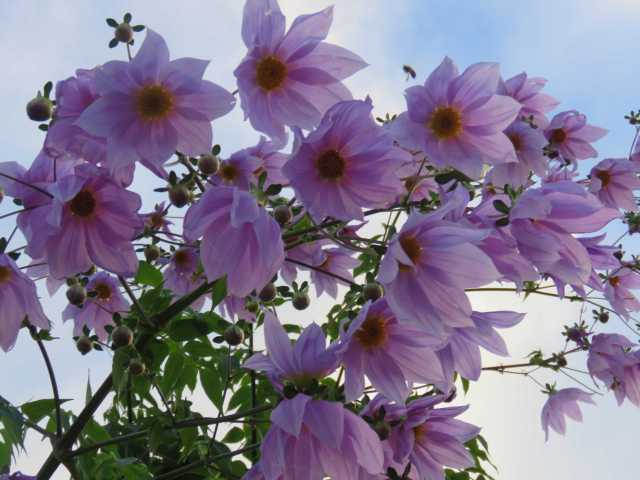
We may be growing older but at least we keep learning things. I recall when our nation first learned about liquefaction in the Christchurch earthquakes. Next was graupel which must have been during the snow event of 2011. This year it is atmospheric rivers. I doubt too many of us knew about these before the Auckland anniversary floods followed by Cyclone Gabrielle. We received weather alerts this week about a potential atmospheric river becoming stalled over Taranaki from Wednesday.
In the event, it didn’t amount to anything close to the devastating floods suffered by many in more northerly and eastern areas of the North Island already this year. It rained hard on Wednesday night – over 90ml which is heading towards 4 inches, Mark tells me from his rain gauges – but since then it has just been showery and drizzly and unusually gloomy. Given that an atmospheric river can release more water than is in the Amazon, we feel we may have dodged a disaster this time.
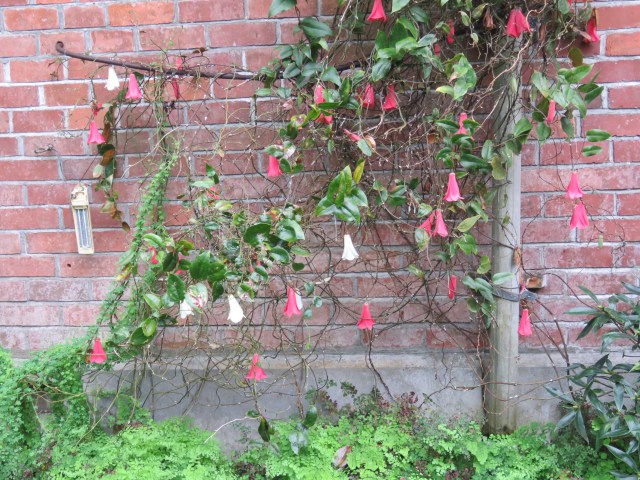
But gloomy is as gloomy does. At least it is not cold. While autumn is here, our daytime temperatures are still sitting around a pleasant 20 celsius and the nights are mild. When the rain stopped yesterday, even though it remained unrelentingly grey, I walked around the garden looking for bright spots.


I have been slow to be won over to the charms of the salvia family. The plants tend to be rangy, leggy, things lacking form but now I have the right places to grow them. They are generous in their blooming habits, flowering for months on end and what I earlier saw as formless sits comfortably in more casual plantings. I think I may need to expand the range and there are certainly plenty to choose from.
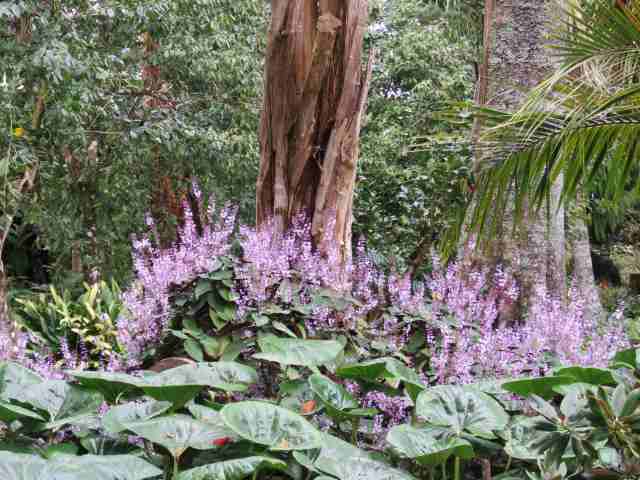
Plectranthus don’t have a good reputation but we accept a few in more casual areas. At least they are easy to hack back and to pull out when they start straying beyond their designated home space. I enjoy that lilac-blue haze behind the Ligularia reniformis. I have no idea which plectranthus this one is but it has a lovely burgundy colour on the underside of the foliage. That gnarly, dead-looking trunk in the centre of the photograph is the remains of my treasured jacaranda that was taken out by Cyclone Dovi in February last year.
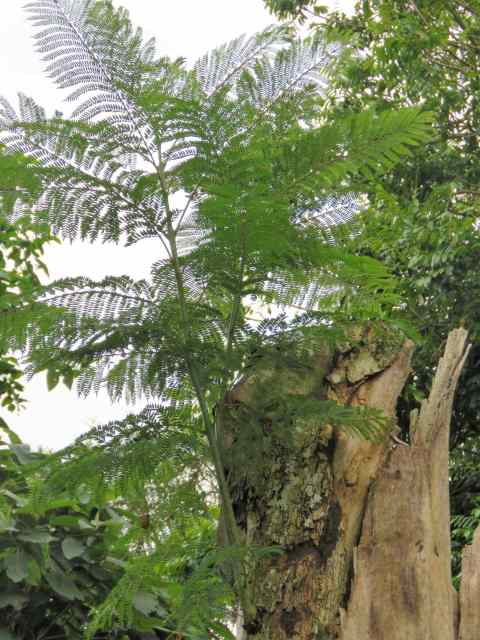
But wait! That is new life on the gnarly old jacaranda trunk. To our great surprise it is shooting again. When Zach spotted the first tiny signs of life, we thought it unlikely to survive because the outer layer of bark on the trunk had been stripped away entirely and we didn’t see how it could sustain new life. But here we are. That shoot is already quite substantial.

I am somewhat dismissive of abutilons which seed way too readily. We weed out most of them but I try and keep the odd one in pure yellow, at least one pure red one and any that have clearly crossed and come in a pleasing orange shade. Anything in murky colours – and there are plenty of those – or in the wrong place is unceremoniouly pulled out and consigned to compost.


Underneath the rimus, the bromeliads provide us with winter colour and a somewhat unique perspective on exotic woodland plantings. Ralph is a bit underwhelmed but he does have a resting sad face and that does not indicate a sad nature. The startling pink variegations in that photo with him are pretty interesting and seem to have stronger colour this year for no discernable reason.
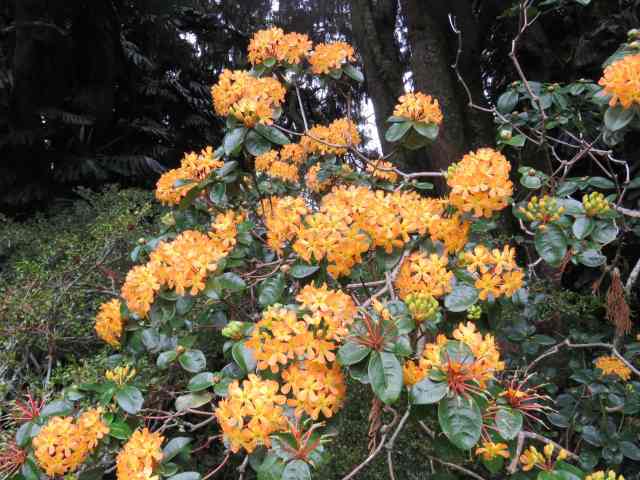
Right on cue, Felix’s New Guinea collection of R. macgregoriae flowers again, as it has done for sixty-five years now. For a vireya, that is an extraordinarily long life span. In our conditions, they are all too often short-lived. All we ever do is dead head it and take out any dead wood. It doesn’t get fed at all but each year it puts on a mass display.
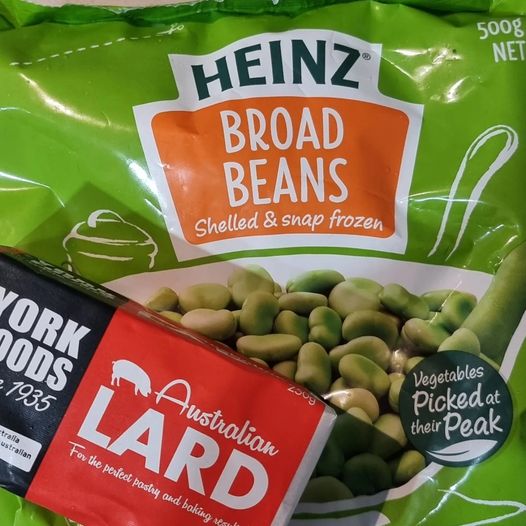
I can not in all honesty say that my corner of the world has been gripped by Coronation fever but I was amused when Canberra daughter announced that the Coronation Quiche looked preferable to its predecessor, Coronation Chicken. Never having tried the latter, I had to google the recipe and that combination of chicken and dried apricot with mayonnaise is very 1950s/60s. Daughter entered into the spirit of the occasion by making an acquaintance with lard, albeit Australian lard, and even posted a photograph of her preparations.
Sadly, she was underwhelmed by the result. While the lard gave a good, flaky pastry, she declared the ratios to be “a bit weird, it’s a lot of cheese and a lot of spinach. The spinach made it a bit earthy and herbaceous. Plus I had forgotten I don’t really like tarragon.”

She remade it, substituting parsley for much of the spinach and adding bacon and declared that preferable.
Going back to Coronation Chicken, I do hope that the New Zealand version was not prepared with Highlander mayonnaise back in the day, Highlander mayonnaise being of a similar era and based on a can of sweetened condensed milk. But I bet it was. With added curry powder from Greggs. ‘The horror, the horror.’

 As 2018 draws to a close, I decided that I do not have anything to say on
As 2018 draws to a close, I decided that I do not have anything to say on 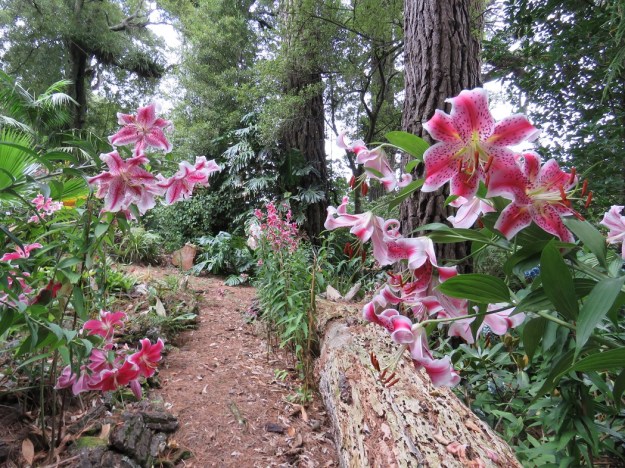 Firstly, January is for lilies.
Firstly, January is for lilies. 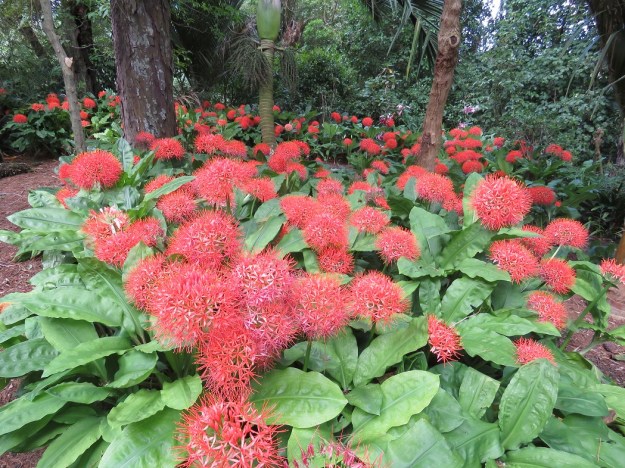 February is peak summer here, when we get the most settled and warmest weather. And the
February is peak summer here, when we get the most settled and warmest weather. And the  March is still summer here although the day length is shortening and the nights noticeably cooler. It used to be a very green time for us, because we have so much woodland garden and there is not a whole lot of high impact flowering in later summer woodland. We went to England three times to look at summer gardens and it is the sunny perennials that flower into this time. It has been really exciting putting in a large summer garden in full sun. I am extremely impressed by the echinaceas which flower from December to April and I have a very soft spot for the blue eryngium, even if I often need to put a stake in to hold them upright.
March is still summer here although the day length is shortening and the nights noticeably cooler. It used to be a very green time for us, because we have so much woodland garden and there is not a whole lot of high impact flowering in later summer woodland. We went to England three times to look at summer gardens and it is the sunny perennials that flower into this time. It has been really exciting putting in a large summer garden in full sun. I am extremely impressed by the echinaceas which flower from December to April and I have a very soft spot for the blue eryngium, even if I often need to put a stake in to hold them upright. By April, we can no longer pretend that summer will go on forever. The flowering of the
By April, we can no longer pretend that summer will go on forever. The flowering of the  May brings us the early camellias in bloom, in this case
May brings us the early camellias in bloom, in this case  June is early winter here. Definitely winter. I could have chosen Mark’s Daphne ‘Perfume Princess’ which flowers on and on through the winter months, but instead I picked Vireya Rhododendron macgregoriae. This particular plant has
June is early winter here. Definitely winter. I could have chosen Mark’s Daphne ‘Perfume Princess’ which flowers on and on through the winter months, but instead I picked Vireya Rhododendron macgregoriae. This particular plant has  July is our bleakest, coldest month. But there is light ahead. July brings us snowdrops and by the end of the month, we have the earliest blooms opening on both the deciduous magnolias and the early michelias. Nothing shouts spring more than the earliest spring blooms. Mark would like some galanthus varieties that flowered later in the season as well and he has tried all that are available, but none of them compete with Galanthus ‘S. Arnott’ for showy and reliable performance and the ability to naturalise in his bulb meadows that are a long-term project.
July is our bleakest, coldest month. But there is light ahead. July brings us snowdrops and by the end of the month, we have the earliest blooms opening on both the deciduous magnolias and the early michelias. Nothing shouts spring more than the earliest spring blooms. Mark would like some galanthus varieties that flowered later in the season as well and he has tried all that are available, but none of them compete with Galanthus ‘S. Arnott’ for showy and reliable performance and the ability to naturalise in his bulb meadows that are a long-term project.
 August – yes there is a lot of snow on our Mount Taranaki. All the better to frame our
August – yes there is a lot of snow on our Mount Taranaki. All the better to frame our  I gave September to the prunus, the flowering cherries. It is probably the campanulatas that are the showiest and they flower in August and I had already allocated that month to magnolias. But we grow quite a range of flowering cherries and this one is down in our wild North Garden, an area that we find particularly charming at this time of the year.
I gave September to the prunus, the flowering cherries. It is probably the campanulatas that are the showiest and they flower in August and I had already allocated that month to magnolias. But we grow quite a range of flowering cherries and this one is down in our wild North Garden, an area that we find particularly charming at this time of the year. October is mid spring. And for October, I chose the clivias yellow, orange and red, seen here with Hippeastrum papilio and dendrobium orchids in the Rimu Avenue. As I selected photos, I realised I was leaning to what we might call our backbone flowering plants – the ones we have a-plenty. Not all of them. I had to skip the azaleas, the michelias, the campanulatas and the hydrangeas owing to my self-imposed restrictions of one per month.
October is mid spring. And for October, I chose the clivias yellow, orange and red, seen here with Hippeastrum papilio and dendrobium orchids in the Rimu Avenue. As I selected photos, I realised I was leaning to what we might call our backbone flowering plants – the ones we have a-plenty. Not all of them. I had to skip the azaleas, the michelias, the campanulatas and the hydrangeas owing to my self-imposed restrictions of one per month.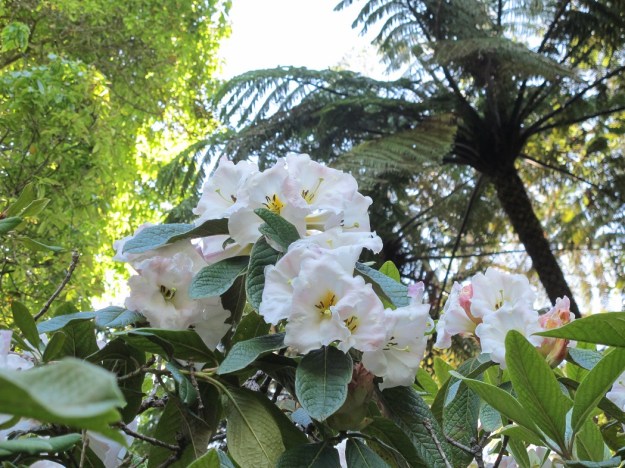 November brings us peak nuttallii and maddenii rhododendrons. The rhododendrons start in August, sometimes the first blooms as early as July, and flower well into December. But the beautiful nuttallis and maddeniis peak in November and are a source of great delight.
November brings us peak nuttallii and maddenii rhododendrons. The rhododendrons start in August, sometimes the first blooms as early as July, and flower well into December. But the beautiful nuttallis and maddeniis peak in November and are a source of great delight. Finally, December is marked by the Higo iris down in the meadow in our park. What prettier way to end the calendar year? And gardening being what gardening is, we start the cycle again with a new year. Best wishes to all readers for a happy and rewarding 2019.
Finally, December is marked by the Higo iris down in the meadow in our park. What prettier way to end the calendar year? And gardening being what gardening is, we start the cycle again with a new year. Best wishes to all readers for a happy and rewarding 2019.